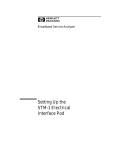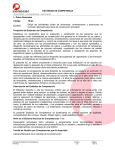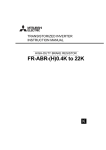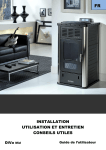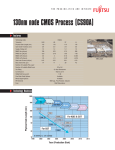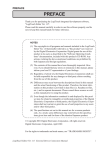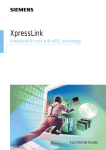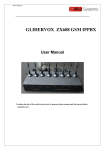Download HP Broadband Service Analyzer User's Manual
Transcript
H Broadband Service Analyzer Setting Up the 25.6 Mb/s Interface Pod Copyright Notice Warranty Printing history © Hewlett-Packard Australia Ltd 1997 All rights reserved. The information contained in this document is subject to change without notice. TO THE EXTENT ALLOWED BY LOCAL LAW, HEWLETT-PACKARD MAKES NO WARRANTY OF ANY KIND WITH REGARD TO THIS MATERIAL, INCLUDING, BUT NOT LIMITED TO, THE IMPLIED WARRANTIES OF MERCHANTABILITY AND FITNESS FOR A PARTICULAR PURPOSE. To the extent allowed by local law, Hewlett-Packard shall not be liable for errors contained herein or for incidental or consequential damages in connection with the furnishing, performance, or use of this material. A copy of the specific warranty terms applicable to your product and replacement parts can be obtained from your local Sales and Service Office. New editions of this guide are issued to reflect extensive changes made to the application. Revisions may be issued between application versions to correct errors in the manual. There may not be a new edition issued in conjunction with every application version release. The application version at the date of printing is noted in the following table. Manual Name: Setting Up the 25.6 Mb/s Interface Pod Manual Part Number: E5129-90001 Product Model Number: HP E5129A Edition 1 Printing Date October 1997 Application Version A.02.0 Visit the Broadband Service Analyzer web site at http://www.hp.com/go/atmanalyzer Product support We want to hear from you. If you have any Hewlett-Packard Australia Ltd Communications Measurements Division Australia comments, questions, or suggestions about our PO Box 221 documentation or support, send them to: Blackburn, 3130 Email: [email protected] Victoria, Australia Fax: +61 3 9210 5570 Phone: +61 3 9272 8633 Printed in Australia Contents Guide to the Broadband Service Analyzer Documentation ..........................iv About the 25.6 Mb/s Interface Pod ................................................................ 1 Online Help ..................................................................................................... 2 To Access User Online Help...................................................................... 2 Front Panel at a Glance ................................................................................. 3 Cable and Line Connector Details ................................................................. 4 Connector Cable Configurations ............................................................... 5 To Set Up the Interface Pod ........................................................................... 6 To Insert the Interface Pod ....................................................................... 7 To Remove the Interface Pod ................................................................... 8 To Connect to the System Under Test ..................................................... 8 Automatic Configuration Parameters ..................................................... 10 To Manually Configure the Interface Pod .............................................. 11 What to Do Next ........................................................................................... 12 Standards and Specifications........................................................................ 13 Communications Standards .................................................................... 13 Physical Specifications ............................................................................ 13 Environmental Specifications ................................................................. 14 iii Guide to the HP E5200A Broadband Service Analyzer Documentation Guide to the HP E5200A Broadband Service Analyzer Documentation The HP E5200A Broadband Service Analyzer comes with a comprehensive set of paper and online documentation. Use the following table to determine which documents you should use. What is it? What does it do? User’s Guide • • • • Who is it for? contains instructions on how to set all users up and install the analyzer provides an outline of the most common functions provides an outline of the most common system administration functions lists electrical, mechanical, and environmental specifications Application Guide contains information on installing and all users starting the application, along with an overview of the application. Online Help four volumes–User, Macro, UPE Compatibility, and Test help–contain information about, and instructions for using, the analyzer all users Quick Reference provides a quick overview of the all users analyzer's main features and functions iv Setting Up the Interface Pod guides a series of guides that provide descriptions of, and instructions for installing, individual interface pods all users will refer to at least one of these guides Worldwide Support card provides information about support, service, and warranty all users Release Notice provides information not available when this guide was printed all users About the 25.6 Mb/s Interface Pod About the 25.6 Mb/s Interface Pod Overview The HP E5129A 25.6 Mb/s Interface Pod is a self-contained, plug-in module. You use it in conjunction with the HP E5200A Broadband Service Analyzer to test and analyze a system under test (SUT). The interface pod generates and analyzes ATM cell streams in a 25.6 Mb/s 4B5B format, in accordance with ATM Forum ATM 25.6 Mb/s over Twisted Pair Cable, af-phy-004.000. Hot swap and automatic configuration Use the “hot swap” feature to insert and remove the interface pod while the analyzer’s power is switched on. The analyzer automatically detects the insertion of the interface pod and configures itself accordingly. Immediately after you connect the interface pod to the SUT, the analyzer automatically configures the receive and transmit parameters according to the signal it receives. Operating modes The interface pod has three operating modes: full duplex, internal transmit loopback, and receive loopback. Components The interface pod is shipped with • • • a Calibration Certificate a set of three connecting cables this Set Up guide Application The HP E5129A 25.6 Mb/s Interface Pod requires an E5200A base unit with Application Version number A.02.0 or greater. Passive monitoring The 25.6 Mb/s Interface Pod has one connector only. To use the interface pod to perform passive monitoring or bi-directional monitoring, you need to obtain a special four-port junction box. See the application notes that come with the interface pod for more details, or visit our web site: www.hp.com/go/atmanalyzer 1 Online Help Online Help The Online Help provides all the information you need to use the analyzer. Refer to the HP Broadband Service Analyzer User’s Guide for information on the Monitor/Simulate help. Refer to theApplication Guide for the B-ISDN UNI Signaling Tests for information on the B-ISDN UNI Signaling Test help. The Online Help contains a Reference section. Use the Reference section to find information about framing formats, alarms, errors, and measurements. To Access User Online Help There are four ways to access information in the User Online Help. 2 • Click the Help button that appears on most screens and windows to display information about that screen or window. • From the main screen Help menu, select User to display the User Contents screen. • Press F1. If the cursor is in an input field, you see help for that field; otherwise you see the User Help Contents screen. Front Panel at a Glance Front Panel at a Glance Access (green LED) Lights each time the interface pod is accessed by the network. Signal (yellow LED) Lights when a valid signal is present at the input connector. I/O Concentrator (UTP) Accepts an electrical signal from and provides a signal to the SUT. 3 Cable and Line Connector Details Cable and Line Connector Details The HP E5129A 25.6 Mb/s Interface Pod’s connector pin configuration adheres to the specification defined in the IBM Corporation’s ATM 25.6 Mb/s PHY Compatibility Specification, Version 2.0, 15 October, 1993. Note In order to comply with EMC regulations, you must use one of the three connection cables that are supplied with the interface pod to connect to the system under test. See Connector Cable Configurations on the next page for details. 4 Cable and Line Connector Details Connector Cable Configurations The interface pod comes with three cables: • part number E1619-64300 connects a user device to the network (2 to 3 in the table below) • part number E1619-64301 connects the interface pod to a user device (1 to 2 in the table below) • part number E1619-64302 connects the interface pod to the network equipment (1 to 3 in the table below) The following table sets out the pin configurations for the three connector types: Pin 8 Pin 1 1. Interface Pod Connector Pin Signal 2. User Device Connector Pin Signal 3. Network Equipment Connector Pin Signal 1 2 3 4 5 6 7 8 1 2 3 4 5 6 7 8 1 2 3 4 5 6 7 8 RxA TxA TxB RxB TxA TxB RxA RxB RxA RxB TxA TxB 5 To Set Up the Interface Pod To Set Up the Interface Pod Caution Handle the interface pod with care to avoid electrostatic discharge (ESD) damage during unpacking, installation, and operation. The connectors on the front and rear of the interface pod are susceptible to ESD. 1 Insert the interface pod into the analyzer. See “To Insert the Interface Pod” on page 7. The procedure is the same for all interface pods. 2 Connect the interface pod to the system under test. See “To Connect to the System Under Test” on page 8. The analyzer automatically recognizes and configures the interface pod. 3 If you want to change any of the configuration parameters, see “To Manually Configure the Interface Pod” on page 11. 6 To Set Up the Interface Pod To Insert the Interface Pod You can insert and remove interface pods at any time, even when the analyzer is powered on. Initially, you insert an interface pod when you set up the analyzer. Subsequently, you insert an interface pod when you change the physical layer interface that you want to monitor. 1 Hold the interface pod with the front panel connectors facing you and the Hewlett-Packard logo facing upwards. 2 Insert the interface pod into Port 1 or Port 2 of the analyzer. 3 Push the interface pod firmly into the analyzer until the connector at the rear is properly seated. The clip on the base of the interface pod clicks into place when the interface pod is fully inserted. Caution You must always have two interface pods inserted in the the HP E5200A Broadband Service Analyzer while it is operating. If your operations require only a single interface pod, insert the blank interface pod (provided with the analyzer) into the other port. The two interface pods are necessary to maintain a balanced airflow for cooling of internal components and to comply with EMC standards. 7 To Set Up the Interface Pod To Remove the Interface Pod Gently press on the clip underneath the interface pod and pull the interface pod out of the analyzer. When you remove the interface pod, make sure you store it in a dust free location that meets the environmental requirements listed in “Environmental Specifications” on page 14. An electrostatic-safe bag has been supplied for the storage of each interface pod. To Connect to the System Under Test Before you connect the interface pod to the system under test (SUT), ensure that you have • • connected the HP E5200A Broadband Service Analyzer to the controlling computer (workstation or notebook PC) inserted the HP E5129A 25.6 Mb/s Interface Pod Select the cable you need from the three provided. See “Connector cable configurations” on page 5. Connect the cable to the UTP connection on the front of the interface pod and to the network element you want to test. 8 To Set Up the Interface Pod Receive (Rx) Some common system and test connections are • • • an intrusive system connection—network element remote loopback in-line test connections See the HP E5200A Broadband Service Analyzer User’s Guide or the Online Help for details about these system connections. The analyzer automatically sets the interface pod transmit and receive parameters and configures according to the signal it receives from the interface pod. See “Automatic Configuration Parameters” on page 10 for more details. If you remove the interface pod and replace it with another while you are logged in to the analyzer, the screen displays the message Auto configuring, please wait... Automatically configuring physical interfaces and protocols according to the monitored signal. Note The UNI Signaling Test Application does not display a message while it performs autoconfiguration. 9 To Set Up the Interface Pod Automatic Configuration Parameters After you insert the interface pod and connect it to the SUT, the analyzer automatically configures to the 25.6 Mb/s electrical signal. The analyzer sets the remaining physical layer receive and transmit parameters to the following defaults: • • • • See also 10 reference (internal) clock full duplex, transmit and receive fill cell filter DISABLED X8 marker generation OFF The Online Help contains information about the ATM and signaling layer automatic configuration parameters. To Set Up the Interface Pod To Manually Configure the Interface Pod 1 From the Configure menu, select the appropriate port; then select Set Up. 2 Click the ATM25 tab. 3 Select the parameters you require. 4 Click to set the configuration or Click Auto to set the parameters to the default settings. A message warns you that the reconfiguration will cause some measurements and data to be lost and asks if you want to continue. Click OK. • Note See the UNI Signaling Test Application’s Help for information on configuring the 25.6 Mb/s interface pod from the B-ISDN UNI Signaling Test Application. When the configuration is complete, the analyzer updates all relevant screens and windows to reflect the new configuration parameters. 11 What to Do Next X8 Timing Marker Source Setting When you change the X8 timing marker source setting, the traffic generator settings are cleared. The analyzer does this because it has to recalculate and re-adjust the total allowable transmit bandwidth to • allow for the X8 marker when you enable X8 marker generation • allocate all available bandwidth to transmit traffic when you disable X8 marker generation Fill Cell Filter Setting This setting allows you to specify that the analyzer generates idle or unassigned cells to fill unused bandwidth. When this option is disabled, unused bandwidth is handled at the physical line level by the transmit drivers. What to Do Next The interface pod is now ready for use. See the Online Help to find out the different tasks you can perform using the analyzer and interface pod. 12 Standards and Specifications Standards and Specifications Communications Standards af-phy-004.400 ATM 25.6 Mb/s over Twisted Pair Cable, ATM Forum ITU-T I.432.5 B-ISDN User Interface for Physical Layer ATM 25.6 PHY compatibility specification IBM Corporation Physical Specifications Weight 1.0 kg ( 2.2 lbs) (nominal) Dimensions Height: Width: Length: 44 mm (1.73 inches) 149 mm (5.87 inches) 222 mm (8.74 inches) 13 Standards and Specifications Environmental Specifications Parameter Min. Max. Notes Operating Temperature 5 oC (41 oF) 45 oC (113 oF) with two interface pods installed Storage Temperature –40 oC (–40 oF) 70 oC (158 oF) Humidity 15% 90% Altitude 14 Nominal 4.6 km (2.86 miles) at 40 oC (104 oF) Certification Hewlett-Packard Australia Ltd (HP) certifies that this product met its published specifications at the time of shipment from the factory. HP further certifies that its calibration measurements are traceable to the extent allowed by the calibration facilities of other International Standards Organization members. Warranty The hardware is warranted against defects in materials and workmanship. If HP receives notice of such defects during the warranty period, HP shall, at its option, either repair or replace hardware products which prove to be defective. HP software and firmware products that are designated by HP for use with a hardware product, when properly installed on that hardware product are warranted not to fail to execute their programming instructions due to defects in materials and workmanship. If HP receives notice of such defects during the warranty period, HP shall repair or replace software media and firmware which do not execute their programming instructions due to such defects. HP does not warrant that the operation of the software, firmware, or hardware shall be uninterrupted or error free. If HP is unable, within a reasonable time, to repair or replace any product to a condition as warranted, Buyer shall be entitled to a refund of the purchase price upon return of the product to HP. For product warranties requiring return to HP, this product must be returned to a service facility designated by HP. Buyer shall prepay shipping charges to HP (and shall pay all duties and taxes) for products returned to HP for warranty service. Except for products returned to buyer from another country, HP shall pay for return of products to Buyer. Duration and Commencement of the Warranty The hardware has a three year, return to HP Service Centre warranty, commencing at delivery date (type 7A). The software and firmware has a 90 day, replacement warranty commencing at delivery date (type 3C). Limitation of Warranty The foregoing warranty shall not apply to defects resulting from improper or inadequate maintenance by Buyer, Buyersupplied products or interfacing, unauthorized modification or misuse, operation outside of the environmental specifications of the products, or improper site preparation or maintenance. TO THE EXTENT ALLOWED BY LOCAL LAW, THE WARRANTY SET FORTH ABOVE IS EXCLUSIVE AND NO OTHER WARRANTY, WHETHER WRITTEN OR ORAL, IS EXPRESSED OR IMPLIED AND HP SPECIFICALLY DISCLAIMS THE IMPLIED WARRANTIES OF MERCHANTABILITY AND FITNESS FOR A PARTICULAR PURPOSE. Exclusive Remedies TO THE EXTENT ALLOWED BY LOCAL LAW, THE REMEDIES PROVIDED HEREIN ARE BUYER’S SOLE AND EXCLUSIVE REMEDIES AND, IN NO EVENT SHALL HP BE LIABLE FOR DIRECT, INDIRECT, SPECIAL, INCIDENTAL, OR CONSEQUENTIAL DAMAGES (INCLUDING LOSS OF PROFITS) WHETHER BASED ON CONTRACT, TORT, OR ANY OTHER LEGAL THEORY. Restricted Rights Legend Use, duplication, or disclosure by the Government is subject to the restrictions as set forth in subdivision (b)(3)(ii) of the Rights in Technical Data and Computer Software clause at 52.227-7-13. HewlettPackard Company, 3000 Hanover Street, Palo Alto, California 94304. Additional Information for Test and Measurement Equipment If test and measurement equipment is operated with unscreened cables and/or used for measurements on open setups, the user has to ensure that under operating conditions the Radio Interference Limits are still met at the border of the user’s premises. Disclaimer Except where otherwise stated, the parameters described are warranted performance specifications. Parameters described as “typical” or “nominal” are supplemental characteristics that provide a useful indication of typical, but nonwarranted, performance. FOR CONSUMERS IN AUSTRALIA, NEW ZEALAND AND THE UNITED KINGDOM: THE WARRANTY TERMS CONTAINED IN THIS STATEMENT, EXCEPT TO THE EXTENT LAWFULLY PERMITTED, DO NOT INCLUDE, RESTRICT OR MODIFY AND ARE IN ADDITION TO THE IMPLIED MANDATORY STATUTORY RIGHTS APPLICABLE TO THE SALE OF THIS PRODUCT TO YOU. Warnings The following general safety precautions must be observed during all phases of operation, service, and repair of this product. Failure to comply with these precautions or with specific warnings elsewhere in this manual violates safety standards of design, manufacture, and intended use of the product. Hewlett-Packard Australia Limited assumes no liability for the customer’s failure to comply with these requirements. Ground the equipment For safety Class 1 equipment (equipment having a protective ground terminal), an uninterruptible safety ground must be provided from the mains power source to the product input wiring terminals or supplied power cable. DO NOT operate the product in an explosive atmosphere or in the presence of flammable gases or fumes. For continued protection against fire, replace the line fuse(s) only with fuse(s) of the same voltage and current rating and type. DO NOT use repaired fuses or short-circuited fuse holders. Keep away from live circuits Operating personnel must not remove equipment covers or shields. Procedures involving the removal of covers and shields are for use by service-trained personnel only. Under certain conditions, dangerous voltages may exist even with the equipment switched off. To avoid electrical shock, DO NOT perform procedures involving cover or shield removal unless you are qualified to do so. DO NOT operate damaged equipment Whenever it is possible that the safety protection features built into this product have been impaired, either through physical damage, excessive moisture, or any other reason, REMOVE POWER and do not use the product until safe operation can be verified by service-trained personnel. If necessary, return the product to a HewlettPackard Sales and Service Office for service and repair to ensure the safety features are maintained. DO NOT substitute parts or modify equipment Because of the danger of introducing additional hazards, do not install substitute parts or perform any unauthorized modification to the product. Return the product to a Hewlett-Packard Sales and Service Office for service and repair to ensure features are maintained. DO NOT clean with fluids Doing so may make the equipment unsafe for use. Safety Symbols Instruction manual symbol affixed to product. Indicates that the user must refer to the manual for specific Warning or Caution information to avoid personal injury, or damage to the product. Protective conductor terminal indicates the field wiring terminal that must be connected to ground before operating the equipment—protects against electrical shock in case of fault. Frame or chassis ground terminal—typically connects to the equipment’s metal frame. Earth (ground) terminal. Alternating current (ac). Direct current (dc). Indicates hazardous voltages. WA R N I N G Calls attention to a procedure, practice, or condition that could cause bodily injury or death. CAU T I O N Calls attention to a procedure, practice, or condition that could possibly cause damage to equipment or permanent loss of data. Indicates that antistatic precautions should be taken. Avertissement Service et ajustement Cet appareil répond aux normes de la “Classe de sécurité 1” et est muni d’un fil de mise à la terre pour votre protection. Des “tensions dangereuses” résident dans cet appareil. Par conséquent, le service et l’ajustement doivent être effectué uniquement par une personne qualifiée. Pour prévenir les risques de choc électrique, la broche de mise à la terre du cordon d’alimentation ne doit pas être désactivée. Restrictions d’utilisation L’utilisateur se doit d’observer les mesures de précaution énumérerais-dessous pour toutes les phases d’utilisation, de service et de réparation de cet appareil. Le fait de ne pas s’y conformer équivaut à ne pas respecter les mises en gardes spécifiques contenues dans ce manuel et constitue une violation des normes de sécurité relatives à la conception, la fabrication et l’utilisation prévue de cet appareil. La société HewlettPackard n’assume aucune responsabilité envers un client qui manquerait de se conformer à ces exigences. Mise à la terre Afin de minimiser les risques de choc électrique, le châssis et le cabinet de l’appareil doivent être mis à la terre. L’appareil est équipé d’un cordon d’alimentation muni d’une fiche homologuée à trois lames, compatible c.a. La prise murale et la prise femelle de la rallonge électrique doivent respecter les normes de sécurité de la “Commission Électrotechnique Internationale” (IEC). Environnement Ne faites pas fonctionner cet appareil en présence de gaz inflammables ou de vapeurs dangereuses. L’utilisation de n’importe quel appareil électrique dans ces conditions constitue un risque élevé pour votre sécurité. Ne remplacez pas de composantes lorsque le cordon d’alimentation est sous tension. Il pourrait y avoir présence de “tension dangereuses” même lorsque l’appareil est déconnecté. Manipulation du tube cathodique Une manipulation brusque, ou le fait de secouer l’appareil, peut provoquer le bris du tube cathodique. L’implosion qui s’en suivrait entraînerait la dispersion à grande vélocité d’éclats de verre. Le retrait ou l’installation du tube cathodique ne doit être exécuté que par un technicien qualifié, portant un masque et des gants de sécurité homologués. Le conducteur protectif indique que la prise de terre doit être connectèe avant d’utiliser l’equipment—protège contre le choc electrique en cas de faute. Borne de terre ou Borne de masse, châssis Courant alternatif Courant continu Service non autorisé L’installation de pièces étrangères, ou tous modification apportée à l’appareil sans le consentement de Hewlett-Packard est formellement interdit. Le fait de procéder à de tels modifications sans autorisation pourrait entraîner l’annulation de la garantie de l’appareil ou de tout contrat de service. Pour un service et des réparations autorisées, retournez l’appareil à un point de vente et service Hewlett-Packard. Symboles des sécurité Attention (voir documents d’accompagnement) Risque de choc electriques WA R N I N G Attire l’attention sur une procédure, une pratique, ou des conditions qui peuvent entraîner des blessures corporelles ou la mort. CAU T I O N Attire l’attention sur une procédure, une pratique, ou des conditions qui peuvent endommager l’équipement. Signale que des précautions antistatique doivent étre prises. Right top margin for modules DECLARATION OF CONFORMITY According to ISO/IEC Guide 22 and EN 45014 body text drop Manufacturer’s Name Hewlett-Packard Australia Ltd Manufacturer’s Address Communications Measurements Division Australia 347 Burwood Highway Burwood East 3151 Victoria, Australia declares that the product: Product Name 25.6 Mb/s Interface Pod Model Numbers HP E5129A Product Options This declaration covers all options of the above product. EMC EN 55011:1991/CISPR 11:1990 (Group 1, Class A1) EN 50082-1:1992 IEC 801-2:1991 2 4 kV CD, 8 kV AD IEC 801-3:1984 3 V/m IEC 801-4:1988 0.5 kV Signal Lines, 1 kV Power Lines Supplementary Information This product herewith complies with the requirements of the Low Voltage Directive 73/23/EEC and the EMC Directive 89/336/EEC. 1The product meets the listed specifications when installed in an HP E5200A with interface pods installed in both ports. 2Bit error performance will be reduced under these conditions. Melbourne, Australia, July 1996 Issue 1 Graeme Cobb - Quality Manager European Contact: Your local Hewlett-Packard Sales and Service Office or Hewlett-Packard GmbH, Department ZQ/ Standards Europe, Herrenberger Straße 130, D-71034 Böblingen, Germany (FAX +49-7031-14-3143). body text bottom margin footer rulling line footer text base line outer margin for text and artwork EN 61010-1: 1993/IEC 1010-1: 1990 + A1 body text left margin Safety hanging column right margin page inner margin conforms to the following product specifications:






















